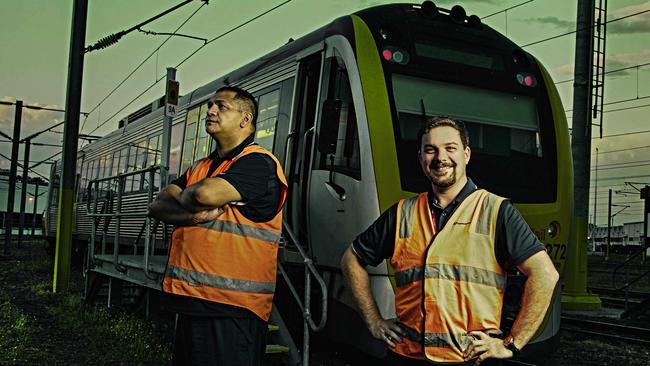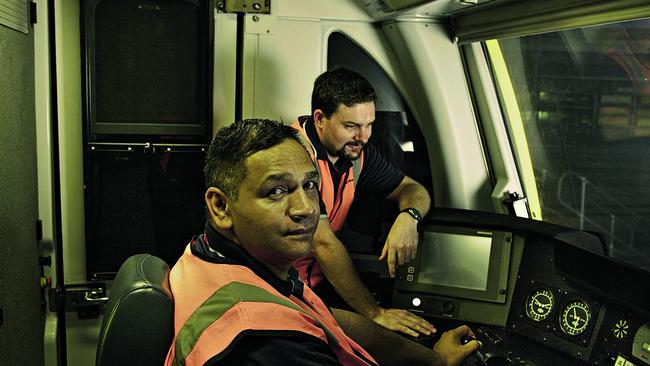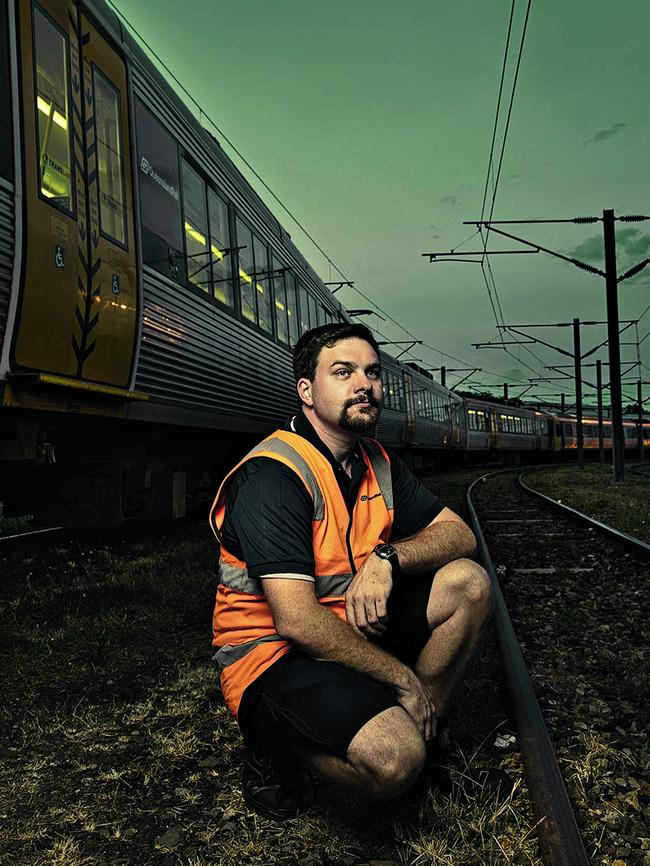Queensland’s ‘rail fail’: What life’s like on the train front line
As public transport meltdowns go, Brisbane’s was a doozy, claiming the scalps of a CEO and a minister. Are these $120K drivers the fix?

The passenger train slows as it approaches Grovely Station, 11 stops north of Brisbane Central, on a lovely winter’s Friday. At precisely 10.10am it comes to a stop and a bloke alights, pulls out a can of bourbon and cola and takes a swig as he passes the train driver’s cabin, occupied by tutor Chris Haag and his trainee, Matau Hohaia. They pay no heed. Hohaia pauses for a few moments and then presses a button on the console, triggering an automated announcement that’s heard throughout the carriages behind his comfortable seat. “Doors closing,” says a calm male voice. “Please stand clear.”
At the end of the platform a few metres from the driver’s seat is a silver pole topped by a single yellow light. “Restricted signal,” says Hohaia, thinking aloud in a coded shorthand for the benefit of his tutor. “So our red will be the red starter at Keperra. We’re going to be taking the 60 for the 80 straight track sign, then 20 over the magnet, stopping at the six-car stop.”
Hohaia reaches a top speed of 60km/h and slows to ease into Keperra Station, bringing the front cabin to a stop beside a mark on the platform that’s no bigger than a dinner plate. This black circle inside a yellow square denotes the proper finishing point for a six-car carriage, part of the Queensland Rail Citytrain service. “Beautiful. It’s surprising just how difficult that is — it takes a lot of practice,” says Haag. “Why thank you,” replies Hohaia with a grin. “I’ve been working on that!”
“And I owe you a jelly bean,” says Haag, referring to the unofficial reward system for trainees who stick the landing at each platform. “You’ll make me a poor man from all those jelly beans!” At 29, Haag is eight years Hohaia’s junior, but the older apprentice has a great respect for the keen eyes and observations of the younger master, who is helping him to finish his training and become one of Queensland’s most precious resources: a qualified train driver.
Despite what you may assume about the rise ofautonomous technology, train drivers will be in demand for years to come — at least on this network. As in other Australian cities, it is largely above-ground and open air, and therefore subject to potential risks from trespassing people and animals. Six-carriage passenger trains in this fleet weigh about 240 tonnes, and the newest units can reach top speeds of 140km/h when pushed to their limit. Each carriage has eight wheels that connect to the rail line through points of contact the breadth of a pencil.
Controlling this metal cylinder as it snakes through Brisbane’s northern suburbs requires two hands: left for the brake lever, right to manage speed. There is something sublime about watching a driver slow this heavy beast on wheels so that it stops exactly where it’s supposed to. It is mundane only because it happens countless times around the country every day; we have become inured to the skill it takes to control these machines traversing vast distances in short times.
Passenger trains have a monopoly on their transport corridors so they are generally dependable if you need to get somewhere on time. It’s only when the system grinds to a halt that we passengers look up from our books, newspapers and devices. It’s only when these trains stop following their once-reliable timetable that we start to wonder about the minor miracle of how, exactly, a modern rail system manages to work so well — most of the time.
Millions of passengers in southeast Queensland have had cause to think about train drivers during the past 12 months due to a rolling series of service interruptions and cancellations that sent shockwaves across the network. The cause of this undue stress was Queensland Rail’s long-awaited opening of an additional line that runs to the bayside suburb of Redcliffe, 25km north of Brisbane City, which was first proposed in 1885. In early October 2016, The Courier-Mail reported that there was “nothing but smiles as Prime Minister Malcolm Turnbull, a renowned train enthusiast, boarded the train for the ceremonial service alongside 230 local ballot winners”.
Once the Redcliffe Peninsula Line was opened, however, the entire network experienced major disruptions that left passengers waiting. And waiting. The issue peaked on October 21 last year, when a whopping 167 Citytrain services were cancelled. Queensland Rail quickly became synonymous with the word “fail” and public frustration was palpable. Commuters in Australia’s third most populous city were suddenly and royally screwed.
By the end of that month, senior Queensland Rail staff including the CEO and chairman of the board had resigned. And in February this year, transport minister Stirling Hinchliffe quit following the publication of a Commission of Inquiry into QR’s train crewing practices. The inquiry found that the government-owned passenger rail service employed 62 fewer qualified train drivers and 83 fewer guards than was needed. “There was a culture within the Operations team of intuitive decision-making, complacency, and reluctance to sharing bad news,” the report said, noting that senior QR figures had been warned about the impending shortfall on four occasions since March 2015.
For a network that’s relied upon by about one million passengers every week, the underemployment of skilled staff was a serious problem. Which explains why tutors such as Chris Haag are now out on the rails every day, instructing the next crop of recruits in order to make up for the deficit of qualified drivers.
The train reaches the end of the Ferny Grove line and tutor and trainee alight from the cab and walk to the other end of the platform. “If he makes it look easy, that’s how you know he’s getting quite advanced in his training,’’ Haag says. “The less I have to talk, the better.”
Matau Hohaia has been in training for only three months but he looks like he knows what he’s doing thanks to the calm confidence he brings to the role. The process of becoming a qualified driver now usually takes 13 months — down from 18 months before the so-called “rail fail”. What is it that has set him on the express route to certification? “My desire to learn, mate,” Hohaia replies as he drops his high-visibility orange backpack into the cabin and settles in to navigate the return journey. “I love taking in information. I’m a machine operator by trade, so I know how machines work.”

More recently, he has worked as a Queensland Rail protection officer, a role that requires close inspection of the tracks. This experience means he has traversed much of the network on foot and so has a hard-earned awareness of every sign and signal between each station. Becoming a driver also appealed for a simple reason that he reveals with a smile: “I got sick of walking.”
Chris Haag, on the other hand, has always loved trains. A self-described “railway kid” whose father has been employed by Queensland Rail since 1977, his sheer enthusiasm would be hard to match across the QR tutor workforce. He’s a train brain, through and through. Haag knows almost everything there is to know about the movement of passenger trains and is practically bursting at the seams to share that knowledge with his trainees, many of whom are older than he is. Haag was 23 when he started at QR as a trainee driver in December 2011. He completed his training in November 2012 and drove trains full-time for four years until deciding to switch to teaching last November.

“One of the common misconceptions about train drivers is that you go station-to-station, whereas the truth is that you go signal-to-signal,” says Haag, as Hohaia pilots the six-carriage unit back towards Brisbane Central. “If the train stops at a section, it’s because there’s a red signal, and it’s usually red for a very important reason. Those coloured lights — that’s a train driver’s life.”
“Green!” announces Hohaia, his eyes focused on the track ahead. “Green it is,” confirms his tutor with a nod. “That signal is what governs our movements. It’s what protects you from other trains, and it tells you where you’re going. Everything you need to know — it’s all in that colour.”
As a trainee, Hohaia earns about$89,000 annually. When he becomes a qualified driver, his salary will increase to about $95,000. Neither of those figures includes overtime, which can bump the total to about $120,000 a year. An average shift lasts eight hours and 25 minutes, including a 40-minute meal break. Haag tends to travel light, and likes to bring fruit and almonds with him. “You’ll probably notice there’s a lot of train crew who aren’t looking the healthiest,” he says. “When you have inconsistent meals, and you’re constantly eating at the wrong time of day, and sitting down for such a long time, it’s not great on the body. I’m still trying to get rid of my driver’s belly; I’ve got another seven kilos to lose before I’m in the healthy range.”
On a daytime run to the Gold Coast the followingweek, Hohaia gestures at the controls in front of him and says, “This is the easy part, to be honest. Obtaining the knowledge of the track and signals is the hardest part.” In the trade, this aspect of driver training is known as route knowledge and involves memorising not only the 13 rail lines and 152 stations but also the location of about 2400 signals across QR’s Citytrain network. “Anyone can drive a train, given a little bit of time,” says Haag. “But learning the route, that’s where it all comes in. If you’re not a very good learner, you’ll struggle with it. It’s a lot of information to try and take in in such a short time.”
The wind whistles past the driver’s cabin as Hohaia’s train reaches 130km/h on the so-called “highway straight”, 11km between Beenleigh and Ormeau stations. Up front it’s easy to forget there are passengers behind us. We’re making such good time, and the sense of speed is so seductive, that it starts to feel as though we’re on this run purely for our own pleasure. The train passes landmarks such as Beattie’s Gap and Keating’s Knob — the latter a small hill where the former PM once had his photograph taken — which are all important in the drivers’ route knowledge.
Having already passed the classroom section of his training, which consists of traction theory and safety and emergency procedures, Hohaia is now focused on driving before his final assessment. An important part of his training is learning that all drivers are human, and therefore fallible. Anecdotally, Haag has heard that drivers who stay in this job for 30 years can expect to accidentally pass one red light, on average, and bear witness to one fatality.
“There are obviously some people who are unlucky enough to have multiple, and those who are lucky who never have them,” says the tutor. “Some people say there’s a red signal out there with your name on it — you just don’t know which one it is. You’ve just got to hope that if you do make a mistake, you mitigate it as best you can, and protect the train as best you can.”
It’s a solitary job. Unlike buses, where drivers and travellers share eye contact and a smile, many train commuters never see or hear their driver — which partly explains the modern assumption that autonomous trains will soon be riding the rails on autopilot. “For the first two years, you can’t have anyone else in the cabin other than during testing or emergencies,’’ says Haag. “The first two years are the most critical, when you’re most at risk — you know just enough to kill yourself.”
On the way back from the Gold Coast, Hohaia brakes at a platform. “You can imagine now, if you weren’t here, and we weren’t talking, how quiet it would be,” he says. “Just being quiet can be really distracting.” His tutor agrees. “It doesn’t take much. Trespassers, something exciting happens on the radio, a nice piece of graffiti — anything that takes your attention away from what’s happening in front of the train, if it’s at the wrong moment, it can make a big difference.” While he speaks, Hohaia’s eyes haven’t moved from the signal ahead. “Still green,” he says to himself.
At night, rail corridors look very different fromthe driver’s cabin. The green, yellow and red signals are more prominent in the darkness and can sometimes be seen hundreds of metres away, but the headlights on the trains don’t show everything that’s ahead. Night-time is when drivers draw upon their knowledge of routes to anticipate what’s coming. Haag likens this skill to a maxim he learnt at flight school: in aviation, never point your nose somewhere you haven’t thought about two minutes earlier. This advice holds true for trains; despite being on a fixed rail, minor errors by the driver or unexpected signal faults can quickly compound, creating knock-on effects across a tightly scheduled network. The result is delayed trains, service cancellations and unhappy passengers.
After its humbling failure, QR is trying to regain public trust and confidence in its services. In the past 12 months, 35 of its 100 new trainees have completed their training to become qualified drivers and Matau Hohaia is one of them — he’s now out there on his own, waving as he zips past his fellow drivers and trainees like ships in the night. If you happen to see him on his lonesome in the driver’s cabin, somewhere in southeast Queensland, be sure to give him a wave. And if his cabin happens to stop on your platform right at that six-car carriage mark, consider offering him a jelly bean. It’ll make his day.

